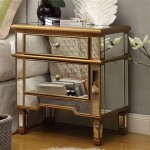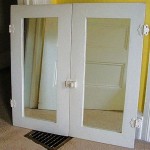Two-Way Mirror Defined
A two-way mirror, also known as a one-way mirror or half-silvered mirror, is a specialized type of mirror that allows viewing from one side while appearing reflective on the other. This seemingly paradoxical function is achieved through a precise application of a metallic coating, typically silver or aluminum, to a glass surface. Unlike a standard mirror where the reflective coating is completely opaque, a two-way mirror's coating is significantly thinner, allowing a portion of light to pass through while reflecting the remainder.
The principle behind the two-way mirror's operation relies on the relative light levels on either side of the glass. In a brightly lit environment, the reflection of light from the mirrored surface dominates, creating a mirror-like appearance. Conversely, in a dimly lit environment, the light transmitted from the brighter side becomes more prominent, enabling observation of the brighter area. This differential in light transmission and reflection is key to the functionality of a two-way mirror.
The manufacturing process of a two-way mirror involves depositing a thin, even layer of metallic material onto a glass substrate. This process, often called vacuum deposition, involves vaporizing the metal in a vacuum chamber and allowing it to condense onto the glass surface. The thickness of this metallic layer is carefully controlled; a thicker layer results in a more reflective surface, while a thinner layer increases light transmission. Achieving the desired balance between reflection and transmission is crucial for optimal two-way mirror performance.
The optical properties of a two-way mirror can be quantified by its reflectance and transmittance. Reflectance refers to the percentage of incident light that is reflected, while transmittance refers to the percentage of incident light that passes through. These values are dependent on the thickness and type of metallic coating, as well as the wavelength of the incident light. Typically, a two-way mirror will have a reflectance of around 50%, meaning that half of the incident light is reflected and half is transmitted. However, these values can be adjusted depending on the specific application.
Several factors influence the effectiveness of a two-way mirror. The most critical factor is the lighting differential between the two sides. A significant difference in light levels is essential for the observational side to remain concealed. If the lighting on both sides becomes similar, the mirror effect diminishes, and visibility becomes reciprocal. Another factor is the angle of incidence, which refers to the angle at which light strikes the mirror surface. The reflectance and transmittance of a two-way mirror can vary slightly depending on the angle of incidence.
Two-way mirrors find applications in a variety of settings, including law enforcement, security, and scientific research. In law enforcement, they are commonly used in interrogation rooms and observation areas, allowing officers to monitor suspects discreetly. Security applications include surveillance in retail stores, casinos, and other public spaces. In research, two-way mirrors are employed in psychological studies and animal behavior research, enabling observation without disturbing the subjects. They are also utilized in architectural design to create unique visual effects and enhance privacy.
The ethical implications of using two-way mirrors are an important consideration. Their use raises concerns about privacy and informed consent, particularly in situations where individuals are unaware of being observed. Regulations and best practices exist to govern the ethical use of two-way mirrors, emphasizing the importance of transparency and respect for individual privacy rights.
Installation of two-way mirrors requires careful planning and execution. The mirror must be properly positioned and secured to ensure optimal functionality and prevent accidental discovery. The surrounding lighting environment must also be carefully controlled to maintain the desired level of concealment. Professional installation is recommended to ensure proper implementation and adherence to relevant regulations.
Distinguishing a two-way mirror from a standard mirror can be challenging, especially for the untrained eye. One method involves observing the reflection of light in a dimly lit environment. A two-way mirror will often reveal a faint image of the brighter side, whereas a standard mirror will simply reflect the darker environment. Another method is the "fingernail test," where placing a fingernail against the mirror surface can indicate the presence of a gap between the reflective surface and the glass, suggesting a two-way mirror. However, this test is not always reliable, as some two-way mirrors are constructed without a noticeable gap.
Advances in technology have led to the development of more sophisticated variations of the two-way mirror concept. These include switchable mirrors, which can transition between transparent and reflective states electronically, and smart mirrors, which incorporate digital displays and other interactive features. These advancements expand the potential applications of two-way mirror technology in various fields.
Proper maintenance and care are essential for preserving the functionality and longevity of two-way mirrors. Cleaning should be performed with non-abrasive cleaners and soft cloths to avoid scratching the delicate metallic coating. Regular inspection for damage or deterioration is also important to ensure optimal performance and security.

How To Tell If A Mirror Is Two Way Or Not 8 Steps With Pictures

How A Two Way Mirror Works

How To Tell If A Mirror Is Two Way Or Not 8 Steps With Pictures

How To Detect A Two Way Mirror Fingernail Test

How To Tell If A Mirror Is Two Way Or Not 8 Steps With Pictures

How To Tell If A Mirror Is Two Way Or Not 8 Steps With Pictures

How To Tell If A Mirror Is Two Way Or Not 8 Steps With Pictures

How To Detect A Two Way Mirror Fingernail Test

Tips For Identifying Whether Your Mirror Is Two Way Or Not Ledmyplace

Convex Mirror Definition Equation Examples Lesson Study Com








